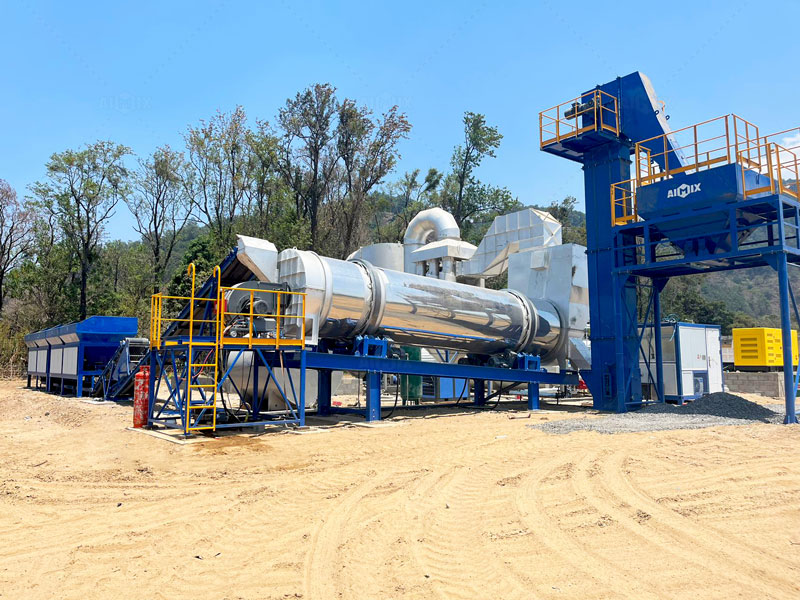Improving the mixing efficiency and quality of an asphalt plant is crucial for ensuring high-performance asphalt production, reducing waste, and enhancing construction outcomes. Whether operating a hot mix asphalt plant, a mobile asphalt plant, or a continuous drum mix asphalt plant, optimizing production processes leads to better pavement durability and cost-effectiveness. This article explores key strategies to enhance mixing efficiency and asphalt quality.
1. Optimize Aggregate Drying and Heating
Aggregates play a vital role in asphalt mix quality for a hot mix asphalt plant(planta de asfalto en caliente). Proper drying and heating ensure optimal adhesion between bitumen and aggregates. To improve this process:
- Use an efficient drying drum – A well-designed drum with a high heat transfer rate improves drying speed and reduces fuel consumption.
- Control moisture content – Excessive moisture in aggregates can lead to improper mixing and increase fuel costs. Pre-screening and stockpile management help maintain ideal moisture levels.
- Ensure uniform heating – Uneven heating causes temperature variations, affecting mix consistency. Calibrating burners and checking flame distribution enhance efficiency.
2. Improve the Asphalt Binder Mixing Process
Bitumen, or asphalt binder, must be properly blended with aggregates for a durable asphalt mix. To enhance the binder mixing process:
- Maintain accurate temperature control – Bitumen should be kept within the recommended temperature range to ensure proper coating and adhesion. Overheating degrades quality, while underheating reduces workability.
- Use high-quality storage tanks – Insulated and temperature-controlled tanks prevent bitumen from hardening or losing performance properties.
- Ensure even binder distribution – Properly designed spraying nozzles and accurate flow meters improve coating efficiency in continuous drum mix asphalt plants(planta de asfalto continua y discontinua).
3. Enhance the Mixing System
The mixing system is the core of asphalt production. Optimizing the mixing process ensures better quality control. Key improvements include:
- Upgrade mixing blades and paddles – Worn-out or inefficient mixing components can lead to uneven material distribution. Regular inspection and replacement improve mixing efficiency.
- Adjust mixing time and speed – Over-mixing or under-mixing can impact the final asphalt properties. Testing different mixing durations helps determine the optimal settings.
- Monitor batch consistency – Automated sensors and weighing systems ensure uniformity in each batch, reducing material wastage.
4. Improve Dust and Fines Control
Excessive dust and fines can affect asphalt mix properties and reduce efficiency. Effective dust control measures include:
- Use high-efficiency dust collectors – Baghouse filters and cyclone separators prevent excess dust from re-entering the mix.
- Recycle fines correctly – Controlled recycling of fines back into the mix enhances cohesion without compromising mix balance.
- Maintain proper ventilation – Ensuring adequate airflow in the mixing drum helps prevent excessive dust buildup.
5. Maintain Proper Material Proportioning
Correct material proportioning is essential for achieving the desired asphalt mix specifications. To improve accuracy:
- Calibrate weighing systems regularly – Load cells and weighing conveyors should be checked frequently to ensure precise aggregate and binder measurements.
- Automate material feeding – Modern control systems regulate material flow to maintain consistent proportions.
- Conduct regular mix design evaluations – Testing different mix formulations helps optimize performance for various road conditions.
6. Increase Energy Efficiency
Reducing energy consumption while maintaining high-quality production improves operational efficiency. Strategies include:
- Use energy-efficient burners – Low-emission and fuel-efficient burners reduce energy costs in hot mix mobile asphalt plants(planta asfaltica movil).
- Optimize drum insulation – Proper insulation minimizes heat loss and enhances fuel efficiency.
- Implement heat recovery systems – Capturing and reusing waste heat lowers fuel consumption.
7. Utilize Advanced Control Systems
Modern asphalt plants benefit from automation and digital monitoring. Advanced control systems improve efficiency by:
- Providing real-time monitoring – Temperature, moisture levels, and material flow are continuously tracked for better process control.
- Detecting inconsistencies early – Automated alerts notify operators of potential mix issues, allowing for quick adjustments.
- Optimizing batch scheduling – Smart scheduling reduces downtime and improves plant productivity.
8. Regular Maintenance and Quality Control
Routine maintenance ensures consistent plant performance and prevents breakdowns. Key maintenance practices include:
- Inspecting critical components – Regularly check dryers, mixers, conveyors, and burners for wear and tear.
- Performing quality tests – Frequent sampling and laboratory testing confirm that asphalt meets required specifications.
- Training plant operators – Well-trained personnel can quickly identify and resolve efficiency issues.
Conclusion
Enhancing the efficiency and quality of an asphalt plant requires a combination of advanced technology, proper material handling, and regular maintenance. Whether operating a mobile asphalt plant, a hot mix asphalt plant, or a continuous drum mix asphalt plant, optimizing production processes leads to superior asphalt performance and reduced costs. By implementing these strategies, asphalt producers can achieve higher productivity, better mix consistency, and improved sustainability in road construction projects.

Comments
No comments yet. Be the first to react!